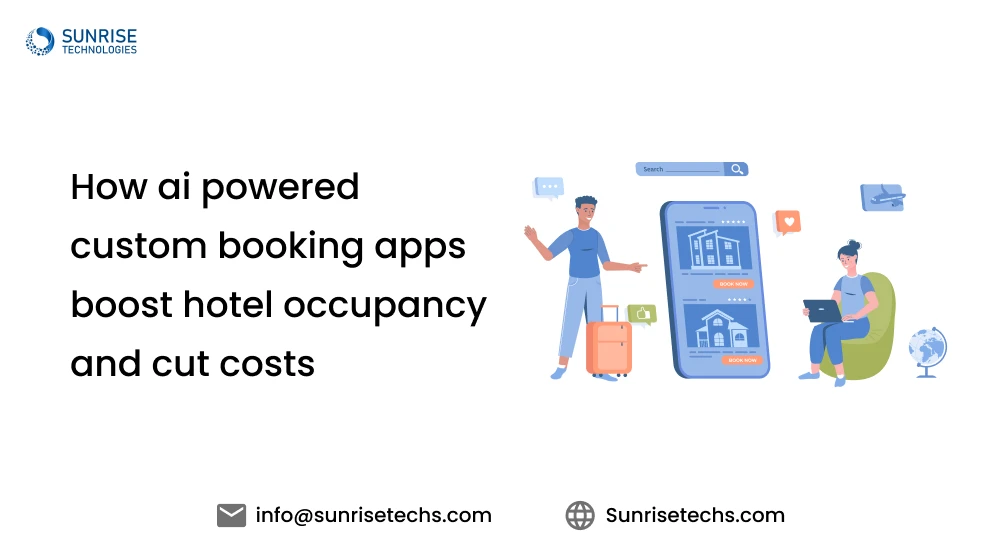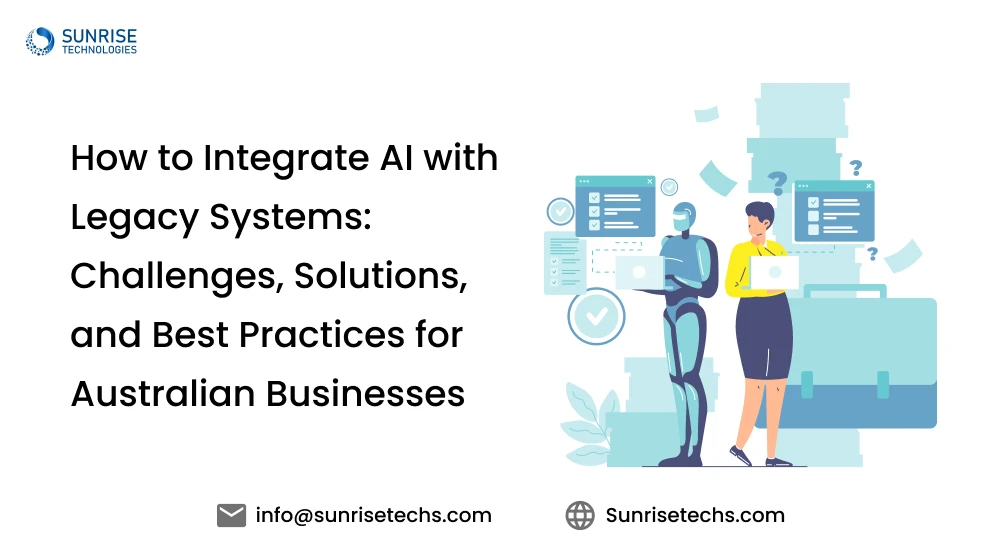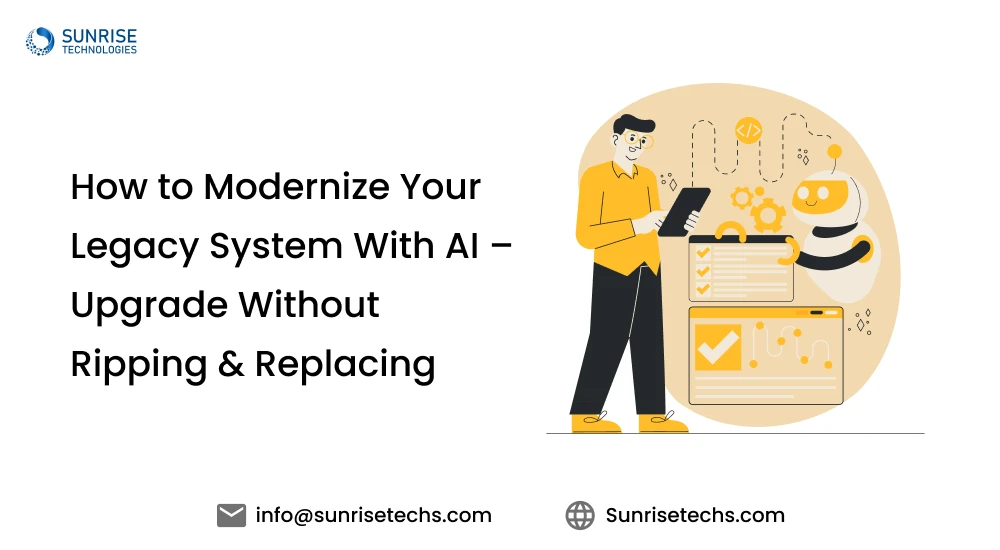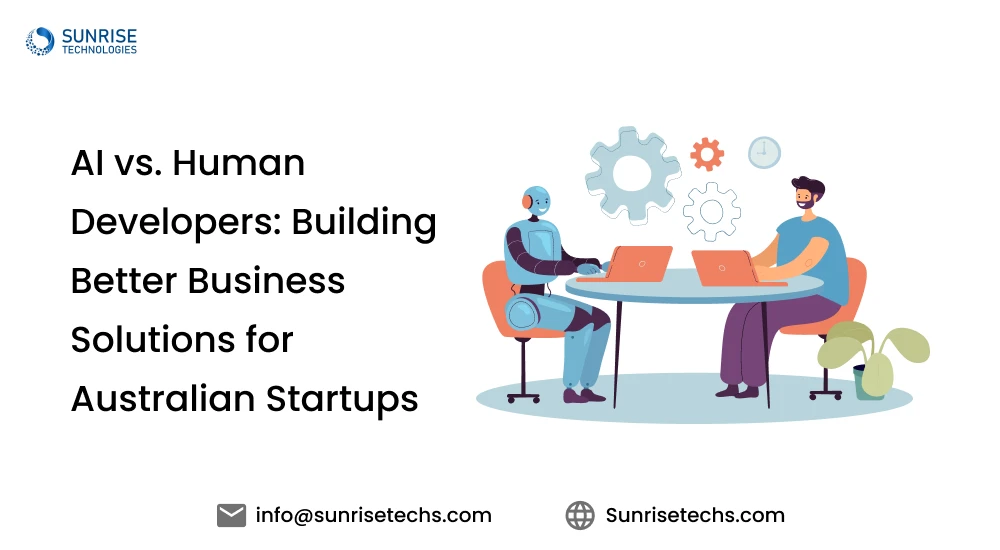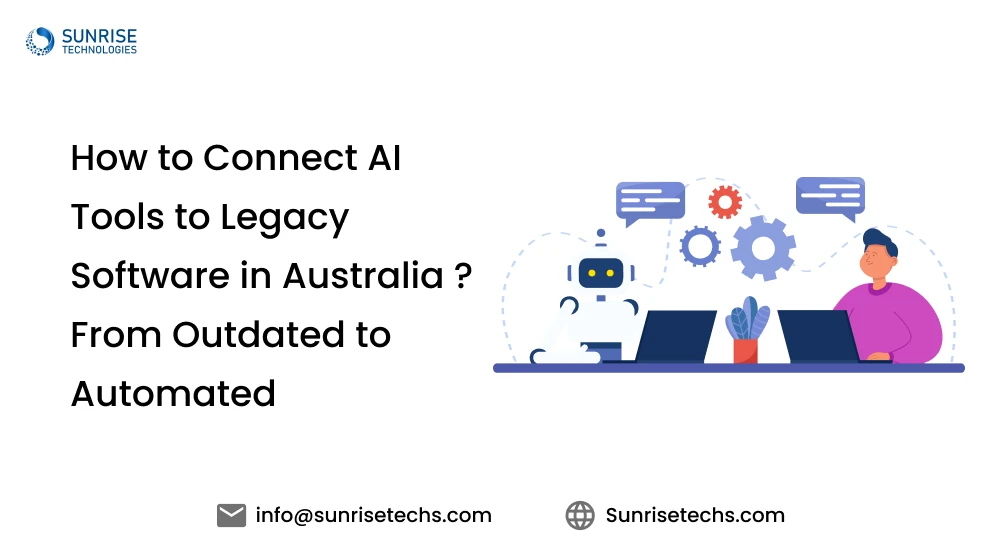
How to Connect AI Tools to Legacy Software in Australia ? From Outdated to Automated
Oct 8, 2025
Did you know that 80% of Australian enterprises still rely on at least one legacy application to run critical operations? Imagine transforming your 25-year-old ERP or CRM into an AI-powered engine that predicts customer needs, automates reports, and scales effortlessly. That’s the future Sunrise Technologies delivers today across Sydney, Brisbane, and Melbourne.
Across Sydney, Melbourne, Brisbane, and every corner of Australia, enterprises still rely on legacy systems—decades-old ERP, CRM, or custom-built software that once ran the business flawlessly. But today, these outdated platforms limit scalability, security, and innovation.
With the right strategy, you can modernize legacy systems with AI—not by scrapping them completely, but by integrating intelligent automation, machine learning, and cloud-driven AI solutions that make old software smarter, faster, and future-ready.
In this blog, you’ll see how moving from outdated to automated is not just possible—it’s profitable.
Why AI Tools for Legacy Software Are a Game Changer?
If you’re running a business in Australia, chances are at least one of your critical systems is older than some of your staff. From COBOL-based banking platforms in Sydney to 20-year-old healthcare EMRs in Brisbane, these systems are the backbone of operations—but they weren’t built for today’s digital-first world.
This is where AI tools for legacy software change the game. Instead of ripping out your system and spending millions on a risky rebuild, you can layer AI capabilities on top of what you already have. Think of it as adding a turbocharger to an old but reliable engine.
Here’s why Australian enterprises are moving fast:
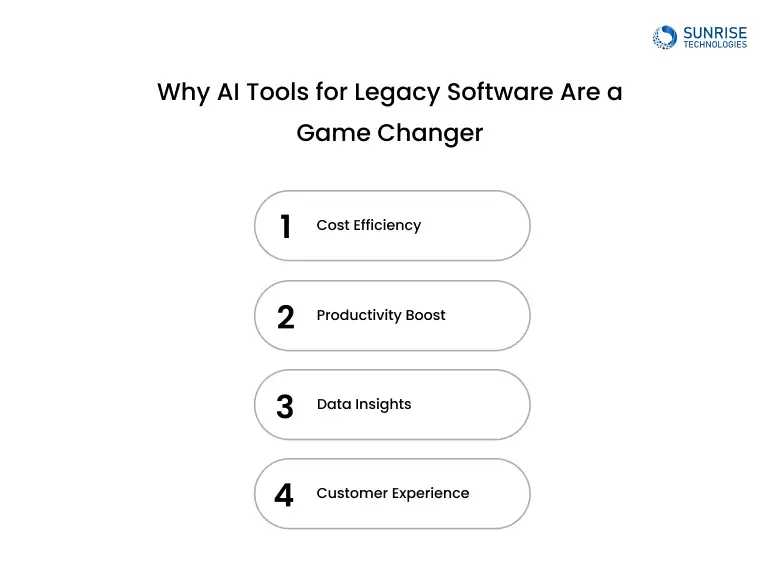
- Cost Efficiency: Replacing a legacy ERP can cost upwards of AUD $2 million and take 2–3 years. By contrast, adding AI modules costs just 10–20% of that and can be deployed in months.
- Productivity Boost: AI automates manual workflows—report generation, approvals, data entry—cutting employee workload by 30–50%.
- Data Insights: Legacy systems hold decades of valuable data, but it’s often trapped in silos. AI + ML tools unlock hidden insights for smarter decisions.
- Customer Experience: Adding AI-driven chatbots and recommendation engines modernizes customer interactions without overhauling your CRM.
Case Study – Sydney Banking Sector
One leading Sydney bank integrated anAI fraud detection engine into its 30-year-old mainframe. Instead of replacing the system, they exposed data via APIs and trained ML models.
Result: Fraud detection accuracy improved by 60%, with zero disruption to daily banking operations.
Find out the real cost of upgrading your legacy systems with AI — no hidden surprises.
The Pain of Staying Outdated (And Why Businesses Upgrade)
If AI tools are the opportunity, then legacy pain is the reality. Ask any CTO in Melbourne or CIO in Brisbane, and they’ll confirm: sticking with legacy systems as-is is costing them money, talent, and innovation.
Here are the top pain points Australian businesses face:
1. High Maintenance Costs
Gartner reports that enterprises spend 60–80% of their IT budget maintaining legacy systems. Every patch, upgrade, and bug fix costs thousands in developer hours.
2. Talent Shortage
Finding COBOL or VB6 developers in Australia is like finding a needle in a haystack. The few who exist charge premium rates, driving costs higher.
3. Security Risks
Legacy systems often don’t comply with APRA, ACSC, and ISO standards for data security. Outdated encryption leaves customer data vulnerable.
4. Data Silos
Legacy apps don’t “talk” to each other or to cloud systems.
Result: duplicate data entry, errors, delays.
5. Customer Experience Gap
In an age of AI chatbots and instant personalization, legacy platforms feel prehistoric. Customers drop off when interactions feel slow or outdated.
Case Study – Brisbane Healthcare Provider
A Brisbane hospital relied on a 15-year-old EMR system. Nurses manually entered vitals, doctors printed reports, and administrators reconciled data at the end of the week. By the time issues surfaced, it was too late. After layering an AI-driven predictive analytics module onto the EMR, patient risk alerts now flag 24 hours earlier, reducing emergency escalations by 22%. That’s why more businesses are moving from outdated to automated. The pain of staying legacy far outweighs the cost of modernization.
What Are the Steps to Connecting AI Tools with a Decades-Old Software System in Australia?
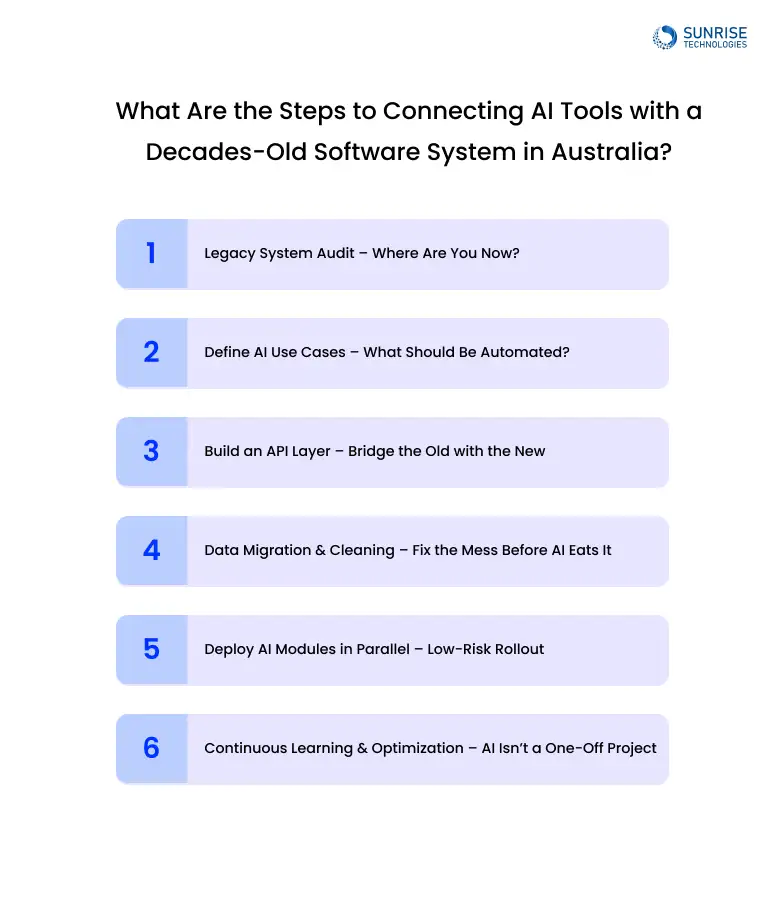
Most Australian enterprises know their systems are old—but ripping them out is like pulling the engine from a plane mid-flight. The smarter way? Layer AI onto existing systems step by step.
Here’s a six-step playbook Sunrise Technologies uses when modernizing a decades-old platform:
Step 1: Legacy System Audit – Where Are You Now?
You can’t modernize what you don’t fully understand. The first step is conducting a system audit to:
- Identify mission-critical apps (must keep running).
- Spot bottlenecks (where staff spend the most manual effort).
- Flag AI-ready areas (where automation will bring fast ROI).
Example: A Sydney-based insurer had a 20-year-old Oracle CRM. Agents still used it for daily customer interactions (mission-critical), but its reporting modules were outdated and prone to errors. The audit revealed AI could be layered on reporting without disrupting core operations.
Deliverable: A heatmap showing where AI delivers immediate value vs. where replacement is inevitable.
Step 2: Define AI Use Cases – What Should Be Automated?
Not all AI projects are worth doing. The key is to find quick wins that save time, cut costs, or boost customer experience.
Typical use cases:
- Customer-facing: AI chatbots, automated onboarding, sentiment analysis.
- Operations: Invoice automation, fraud detection, predictive maintenance.
- Healthcare/Finance specific: Patient triage, risk scoring, compliance checks.
Example: A Brisbane hospital added AI-driven patient triage into its legacy EMR (electronic medical record). Nurses now receive AI-prioritized alerts, cutting triage time by 40% and improving patient outcomes.
Pro Tip: Don’t build AI for AI’s sake. Choose use cases where staff adoption is guaranteed.
Step 3: Build an API Layer – Bridge the Old with the New
Legacy systems weren’t designed for today’s cloud-first, AI-driven world. The solution? API layers.
- APIs act as “connectors” between closed systems and modern AI tools.
- They allow AI models to pull and push data in real-time.
- Think of it as giving your old system USB ports for AI to plug in.
Australian Example: A Melbourne retailer had a COBOL-based POS system that couldn’t connect with AI demand forecasting models. Sunrise built a REST API layer, unlocking real-time data flow. Suddenly, AI-powered stock prediction became possible.
Without APIs → Data stays locked.
With APIs → AI flows in like electricity.
Step 4: Data Migration & Cleaning – Fix the Mess Before AI Eats It
AI is only as good as the data it’s trained on. Legacy systems often store:
- Messy formats (inconsistent dates, currencies, IDs).
- Duplicate entries (same customer with 3 profiles).
- Incomplete fields (missing transaction histories).
Solution: Use AI-powered ETL (Extract, Transform, Load) tools to:
- Map fields correctly.
- Normalize data formats.
- Detect & auto-fix duplicates.
Example: A Sydney bank converted 30 years of mainframe transaction records into ML-friendly data formats. The migration happened without downtime, so customer banking wasn’t disrupted.
Deliverable: A clean, AI-ready data lake where legacy and new data meet.
Step 5: Deploy AI Modules in Parallel – Low-Risk Rollout
Never flip the switch overnight. Instead:
- Run legacy + AI side by side.
- Start with a pilot module (chatbot, fraud detection, or predictive maintenance).
- Compare results before scaling AI across departments.
Example: A Brisbane logistics firm kept its old supply chain software but added an AI predictive maintenance module for trucks. For six months, both systems ran in parallel—so if AI made an error, legacy still backed it up. Once accuracy hit 95%, the AI system took the lead.
Step 6: Continuous Learning & Optimization – AI Isn’t a One-Off Project
Unlike traditional IT projects, AI evolves over time. After deployment, companies should:
- Track KPIs: cost per transaction, customer satisfaction scores, time saved.
- Retrain models monthly with new data.
- Expand AI modules gradually (chatbot → workflow automation → predictive analytics).
Example: An insurance firm in Perth started with AI claims triage. Within 12 months, accuracy improved 20% as the AI model “learned” from thousands of real cases. Now, they’re adding AI-driven fraud detection.
Explore real AI transformation stories from Sydney, Melbourne, and Brisbane enterprises.
Challenges & Risks of AI Modernization in Australia
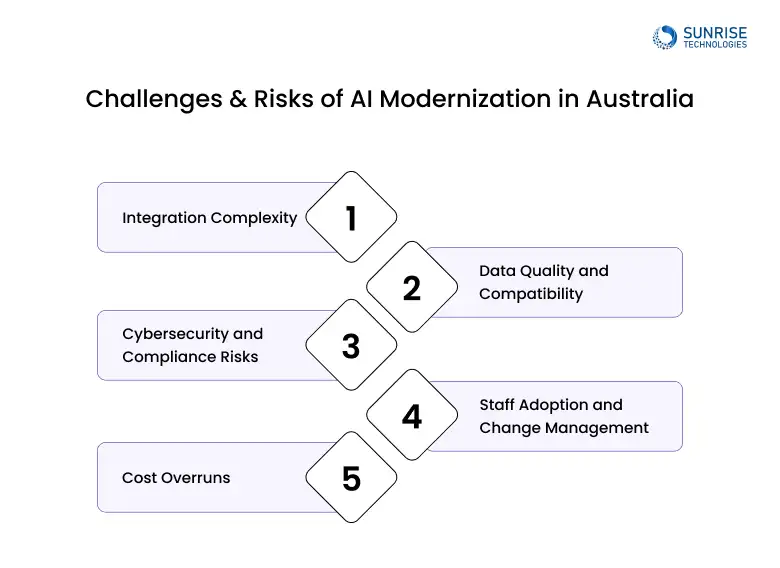
Modernizing decades-old systems with AI can deliver transformative results, but it comes with challenges. Understanding these risks upfront helps enterprises prepare, budget correctly, and ensure a smooth transition.
1. Integration Complexity
Legacy systems were never designed with AI in mind. Their closed architecture, hard-coded dependencies, and lack of documentation make integration technically complex. This can slow down projects if not carefully planned.
2. Data Quality and Compatibility
AI thrives on structured, high-quality data. Legacy systems often store inconsistent formats, duplicates, and incomplete records, which must be cleaned and normalized before AI can deliver accurate results.
3. Cybersecurity and Compliance Risks
Opening legacy systems to AI via APIs or cloud connections introduces new attack surfaces. Without proper encryption and governance, enterprises risk data breaches and non-compliance with regulations like GDPR, APRA, or HIPAA.
4. Staff Adoption and Change Management
AI modernization is as much about people as it is about technology. Employees may distrust automation or fear job displacement. Without proper training and communication, adoption rates can remain low.
5. Cost Overruns
AI projects often exceed budgets if underestimated. Unplanned expenses in data migration, API development, or ongoing AI model training can lead to higher-than-expected costs if there is no phased rollout strategy.
What Role Do APIs Play in Connecting AI with Older Software?
Here’s the truth: APIs are the unsung heroes of AI modernization. Without them, your legacy system is a locked box. With them, it becomes an AI-ready engine.
1. Why APIs Are Critical
- Data Access: APIs let AI “talk” to systems that weren’t built for integration.
- Flexibility: Instead of replacing your legacy app, APIs extend it.
- Scalability: APIs make it possible to add multiple AI tools (chatbots, analytics, automation) without changing core code.
Think of APIs as adapters—like plugging a USB-C cable into an old Nokia charger port. Suddenly, old meets new.
2. Types of APIs Used in AI + Legacy Integration
- REST APIs – Common for cloud + AI connections (used in ERP/CRM upgrades).
- SOAP APIs – Often needed for older systems like Oracle, SAP, IBM.
- Custom Middleware APIs – Built when no standard interface exists.
3. API Benefits for Enterprises
- Cost Savings: Avoid total system replacement.
- Speed: Faster rollout of AI features.
- Future-Proofing: Once an API layer exists, new AI tools can plug in easily.
Global & Industry-Specific Impact of AI on Legacy Modernization
Modernizing legacy systems with AI isn’t just a local trend — it’s a global shift, with Australian enterprises catching up fast. Different industries benefit in unique ways, but the core outcome is the same: outdated systems become future-ready.
1. Banking & Financial Services
- AI enhances fraud detection, compliance checks, and customer service chatbots.
- Legacy mainframes become AI-powered engines for real-time transaction monitoring.
- Result: Faster processing, fewer errors, improved customer trust.
2. Healthcare
- AI adds predictive diagnostics and patient triage to outdated EMRs.
- Legacy hospital systems become interoperable with wearable devices and telehealth platforms.
- Result: Reduced wait times and improved patient outcomes.
3. Logistics & Manufacturing
- AI modules predict supply chain disruptions and machine breakdowns.
- Outdated ERP systems integrate with AI forecasting tools.
- Result: Lower operational costs and higher delivery reliability.
4. Retail & E-Commerce
- AI-driven personalization layers onto old POS and CRM systems.
- Recommendation engines increase upsell and cross-sell revenue.
- Result: Higher sales conversion and improved customer loyalty.
Why It Matters Globally
In 2025, 40% of enterprises worldwide are expected to modernize at least one critical legacy system with AI. Australia, with its mix of traditional industries (banking, mining, healthcare) and digital-first startups, is uniquely positioned to benefit.
Speak directly with our AI consultants and discover how to future-proof your business.
Best AI Development Services in Australia Specializing in AI Integration with Legacy Systems?
Yes — and in fact, specialized consulting is the single most important factor in successful AI modernization projects. Many Australian enterprises underestimate the expertise needed to connect decades-old systems with modern AI. This is where consulting partners step in.
Why Consulting Matters?
- Strategic Assessment: Consultants evaluate whether modernization, replacement, or hybrid approaches deliver the best ROI.
- Technical Expertise: They understand both old programming environments (COBOL, Oracle, SAP, Lotus Notes) and modern AI stacks (TensorFlow, PyTorch, LLM-based tools).
- Risk Mitigation: By spotting issues early, they prevent cost blowouts, downtime, and compliance violations.
- Change Management: Consultants help train teams and build trust so AI adoption doesn’t stall.
The Australian Landscape
Across Sydney, Brisbane, and Melbourne, companies are increasingly seeking AI-first consulting firms rather than traditional IT vendors. These firms specialize in:
- Building API layers for closed systems.
- Migrating legacy data into AI-ready cloud environments.
- Designing AI modules (chatbots, automation, fraud detection, predictive analytics) tailored to industries like healthcare, finance, logistics, and retail.
Why Sunrise Technologies Leads?
At Sunrise Technologies, we don’t just deliver technical solutions — we provide end-to-end consulting. From system audits to deployment and ongoing optimization, our team ensures legacy modernization projects in Australia succeed without downtime. This consultative approach is why enterprises in Sydney, Melbourne, Brisbane, and beyond trust us as their AI development partner of choice.
What Is the Cost of Upgrading Legacy Applications with AI in 2025?
One of the first questions every CIO or CTO asks is: “How much will it cost to modernize my legacy system with AI?”. The answer depends on multiple factors — but it’s important to see cost not just as an expense, but as an investment in future competitiveness.
Key Cost Drivers:
- System Complexity: A simple CRM add-on (chatbot integration) is cheaper than modernizing a 30-year-old ERP running supply chains across Australia.
- Data Migration & Cleaning: Data preparation often takes up 30–40% of the budget, since AI models need high-quality inputs.
- API Development: If your legacy system has no standard APIs, custom middleware may need to be built.
- AI Modules Chosen: Costs vary depending on use cases — chatbot automation is relatively low-cost, while predictive analytics or fraud detection requires more advanced (and expensive) AI models.
- Cloud vs. On-Prem Deployment: Migrating to the cloud with AI can reduce long-term costs but involves upfront investment.
- Ongoing Optimization: AI isn’t “set and forget.” Retraining models and updating integrations add to yearly costs.
Typical Cost Ranges in Australia
- Small-Scale AI Add-On (chatbots, simple automation): AUD $30,000 – $50,000
- Mid-Level Integration (ERP/CRM AI modules, predictive analytics): AUD $50,000 – $150,000
- Enterprise-Grade Modernization (full system audit, multi-module AI, data lake creation): AUD $200,000 – $1M+
The Cost Range at Sunrise Technologies
- Small-Scale AI Add-On (chatbots, simple automation): $5,000 – $15,000
- Mid-Level Integration (ERP/CRM AI modules, predictive analytics): $25,000 – $50,000
- Enterprise-Grade Modernization (full system audit, multi-module AI, data lake creation): AUD $50,000+
Why Choose Sunrise Technologies for AI-Powered Legacy Modernization?
Modernizing legacy systems with AI is not just a tech upgrade — it’s a profit and performance accelerator. Sunrise Technologies helps Australian enterprises unlock measurable business outcomes, not just “better IT.”
Tangible Value We Deliver
- Cost Savings up to 40% on IT Operations: Legacy maintenance eats 60–80% of IT budgets. By shifting workloads to AI-powered automation and cloud connectors, we cut recurring support costs dramatically.
- Revenue Growth of 15–25% via AI Enablement: With AI-driven personalization, predictive analytics, and intelligent chatbots, businesses see higher conversion rates, increased customer lifetime value, and improved cross-selling.
- Integration at Half the Usual Cost: Instead of full rip-and-replace (often costing millions), we layer AI tools and APIs on top of existing systems — delivering modernization at 50% less investment.
- Faster Time-to-Market: Deploy new features and AI-powered modules in weeks instead of years. This agility helps you outpace competitors.
- Boost in Workforce Productivity (30–40%): AI automation eliminates repetitive admin work. Your teams focus on high-value tasks, not data entry.
- Regulatory & Security Compliance Built-In: AI tools ensure compliance with Australian data protection, finance, and healthcare standards — reducing risk of fines or breaches.
- Future-Proofing Against Disruption: AI modernization ensures you’re ready for next-gen innovations like autonomous workflows, hyper-personalization, and GenAI assistants.
At Sunrise Technologies, we don’t just modernize — we deliver ROI. Imagine reducing IT spend by 40% annually, unlocking 20% new revenue opportunities, and doubling customer satisfaction — all by upgrading your legacy systems with AI. That’s the Sunrise Advantage — trusted by enterprises across Sydney, Melbourne, Brisbane, and worldwide.
Final Thoughts
Your competitors aren’t waiting — they’re already using AI to cut costs, boost revenues, and stay ahead. If your business is still running on outdated software, every month you delay means lost efficiency, higher IT spend, and missed growth opportunities.
Yes. The best practice is to deploy AI modules in parallel with existing systems (shadow mode). For example, predictive analytics or chatbots can run alongside your legacy ERP/CRM before becoming the primary. This ensures zero disruption during rollout.
When systems lack modern APIs, developers create a custom middleware or API layer that acts as a bridge. This allows AI tools to securely access, process, and return data without altering the original codebase.
Legacy data often has inconsistencies, duplicates, and gaps. Before AI adoption, we use AI-powered ETL pipelines to clean, normalize, and migrate data into an AI-ready format — ensuring ML models train on accurate inputs.
All integrations include end-to-end encryption, audit trails, and regulatory frameworks aligned with Australian standards. Compliance is embedded during the design phase to prevent costly retrofits later.
Beyond development, hidden costs can include:
- Data preparation (often 30–40% of total budget).
- Ongoing AI model training (to adapt to new data).
- Staff adoption and change management (training sessions, workflows).
A phased roadmap helps anticipate and reduce overruns.
Change management is built into the process. We run pilot programs, involve staff in feedback loops, and show productivity gains. Employees are trained to collaborate with AI rather than fear job loss.
Yes — even closed systems can be modernized via screen scraping, database connectors, or middleware APIs. AI doesn’t replace the old system; it layers intelligence on top of it.
We measure ROI using hard savings (lower IT maintenance, fewer developer hours), soft savings (improved decision-making, faster workflows), and revenue uplift (AI-driven personalization, fraud reduction, customer retention).
AI modules first run in shadow mode — where they generate predictions or actions in the background while the legacy process continues. Once accuracy reaches the agreed threshold (e.g., 95%), the AI takes over production.
AI can work with both. For heavily regulated industries (banking, healthcare), on-prem AI modules can be deployed. For scalability and lower costs, cloud + hybrid approaches are often recommended.
Sam is a chartered professional engineer with over 15 years of extensive experience in the software technology space. Over the years, Sam has held the position of Chief Technology Consultant for tech companies both in Australia and abroad before establishing his own software consulting firm in Sydney, Australia. In his current role, he manages a large team of developers and engineers across Australia and internationally, dedicated to delivering the best in software technology.
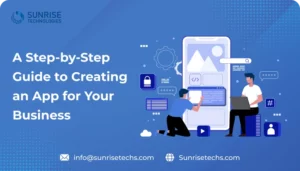

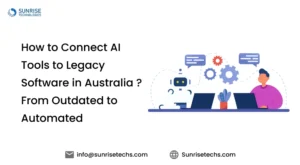

Cloud Based Project Management Platform
Read the challenges we faced and how we helped
View Case Study


